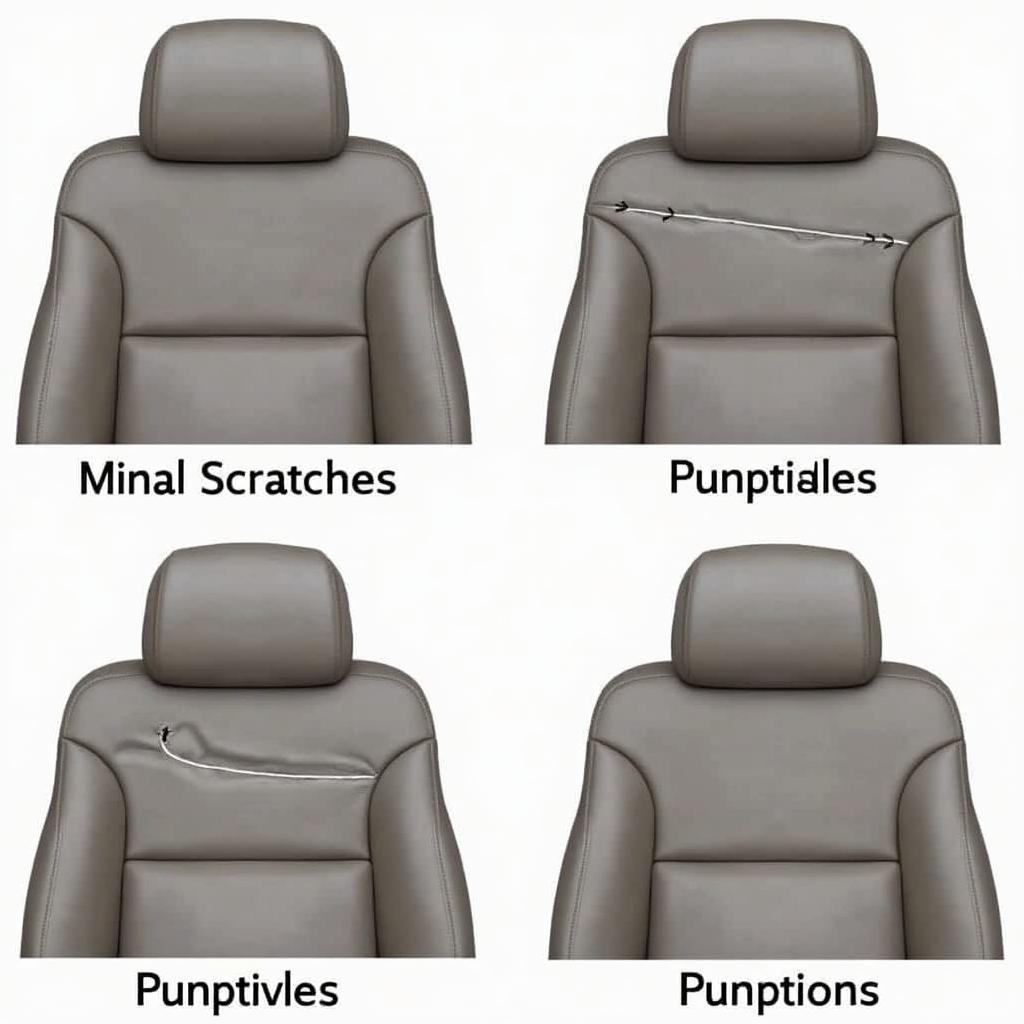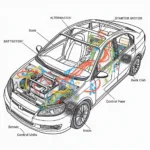Leather car seats are a luxurious feature that enhances the comfort and style of your vehicle. However, they are susceptible to tears, punctures, and other damages over time. While it might seem daunting, repairing tears in leather car seats is achievable with the right tools and techniques. This comprehensive guide will walk you through the process, empowering you to restore your car’s interior to its former glory.
Understanding Leather Car Seat Damage
Before diving into the repair process, it’s crucial to assess the extent of the damage. Tears can be caused by various factors, including sharp objects, friction from clothing, and general wear and tear.
- Minor Tears and Scratches: These are superficial damages that only affect the top layer of the leather. They can often be addressed with DIY repair kits or leather conditioners.
- Deep Tears and Punctures: These damages penetrate multiple layers of the leather and require more advanced repair techniques.
- Burns and Cracks: Caused by extreme temperatures or prolonged exposure to sunlight, these damages often require professional attention.
DIY Repair vs. Professional Upholstery
Deciding whether to tackle the repair yourself or seek professional help depends on the severity of the damage and your comfort level with DIY projects.
DIY Repair:
- Suitable for: Minor tears, scratches, and surface-level damages.
- Advantages: Cost-effective, convenient, and can be accomplished with readily available repair kits.
- Disadvantages: Might not provide a perfect finish for deep tears or complex damages.
Professional Upholstery:
- Suitable for: Deep tears, punctures, burns, cracks, and extensive damages.
- Advantages: Guaranteed quality repair, professional finish, and access to specialized tools and materials.
- Disadvantages: More expensive than DIY solutions.
Essential Tools and Materials for DIY Repair
If you choose to repair the tear yourself, you’ll need the following tools and materials:
- Leather Repair Kit: These kits typically contain a color-matched repair compound, adhesive, backing fabric, a spatula, and a color blending solution.
- Cleaning Solution: Use a dedicated leather cleaner or a mild soap solution to remove dirt and debris from the damaged area.
- Rubbing Alcohol: This helps to degrease the leather surface, ensuring proper adhesion of the repair compound.
- Microfiber Cloths: Soft and lint-free cloths are essential for cleaning and applying repair products.
- Scissors: Used to cut the backing fabric and any loose threads around the tear.
- Hair Dryer (optional): Helps to speed up the drying time of the repair compound.
Step-by-Step Guide to Repairing Tears in Leather Car Seats
Follow these steps carefully to achieve the best possible results:
- Clean the Damaged Area: Use a leather cleaner or mild soap solution to thoroughly clean the area around the tear. Allow the leather to dry completely.
- Trim Loose Threads: Carefully trim any loose threads or frayed edges around the tear using sharp scissors.
- Apply Backing Fabric (if necessary): For deep tears or punctures, use the backing fabric provided in the repair kit to create a supportive base for the repair compound. Cut the fabric slightly larger than the tear and adhere it to the underside of the leather using the adhesive provided.
- Fill the Tear: Using the spatula, carefully fill the tear with the leather repair compound, ensuring a smooth and even surface.
- Remove Excess Compound: Gently scrape away any excess compound with the spatula, leveling it with the surrounding leather surface.
- Heat Set the Compound (optional): If your repair kit recommends heat setting, use a hairdryer on a low setting to speed up the drying process. Hold the hairdryer a few inches away from the surface and avoid overheating.
- Apply Color Blending Solution (if necessary): If the repair compound doesn’t perfectly match the leather color, use the color blending solution to create a seamless transition.
- Apply Leather Conditioner: Once the repair is complete and dry, apply a high-quality leather conditioner to the entire seat. This helps to moisturize the leather and prevent future cracking.
Tips for a Seamless Repair
- Choose the Right Color Match: Select a leather repair kit that closely matches the color of your car seats. If in doubt, consult with a professional or contact the car manufacturer.
- Work in a Well-Ventilated Area: Some leather repair compounds have a strong odor, so ensure adequate ventilation during the repair process.
- Practice Patience: Leather repair requires precision and patience. Take your time and allow ample drying time between each step.
- Consider Professional Help for Complex Damages: For deep tears, punctures, burns, or if you’re unsure about your DIY skills, it’s best to seek professional upholstery services.
Frequently Asked Questions (FAQs)
Q: Can I use superglue to repair a tear in my leather car seat?
A: While superglue might seem like a quick fix, it’s not recommended for leather car seat repairs. It can create a stiff and inflexible bond that is prone to cracking over time.
Q: How long does it take for leather repair compound to dry?
A: Drying times vary depending on the type of repair compound and environmental factors. In general, allow at least 24 hours for the compound to cure completely.
Q: Can I prevent future tears in my leather car seats?
A: Regular cleaning and conditioning, using seat covers, and being mindful of sharp objects can help prevent future tears in your leather car seats.
Conclusion
Repairing tears in leather car seats is a manageable task that can save you money and preserve the aesthetic appeal of your vehicle’s interior. By following this guide and utilizing the right tools and techniques, you can restore your leather seats to their former glory. However, remember that professional upholstery services are always an option for complex damages or if you prefer a guaranteed expert finish.
Do you have any further questions or need assistance with your car seat repair? Feel free to reach out to our team of experts via WhatsApp: +1(641)206-8880, or email us at: [email protected]. We’re available 24/7 to assist you.



